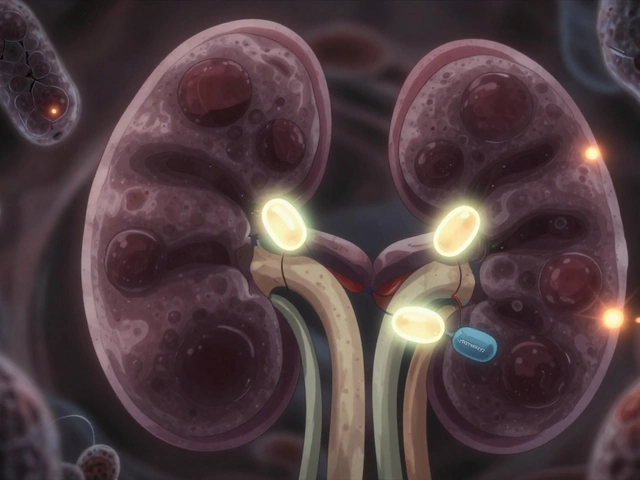Health November 17, 2025
OTC Gas and Bloating Remedies: Simethicone vs Enzyme Products Explained
When you feel bloated, tight, or swollen after eating-like your stomach is a balloon about to pop-you don’t need to suffer through it. Over-the-counter (OTC) gas and bloating remedies are one of the most common ways people find quick relief. But not all of them work the same way. Two main types dominate the shelves: simethicone and enzyme products. Knowing the difference can save you time, money, and discomfort.
What Simethicone Actually Does
Simethicone isn’t a magic bullet that stops gas from forming. Instead, it tackles the symptom: the trapped bubbles. Think of it like popping soap bubbles in a sink. When gas gets trapped in your gut, it forms tiny, stubborn bubbles that cause pressure and pain. Simethicone breaks the surface tension of those bubbles, making them stick together into bigger ones that are easier to pass out-through burping or flatulence.
It’s been around since the 1950s and doesn’t get absorbed into your bloodstream. That’s why it’s safe for kids, pregnant people, and those on other medications. You’ll find it in brands like Gas-X, Mylicon, and Phazyme. A typical dose is 40 to 125 mg, taken after meals or when you feel bloated. Most people feel relief within 15 to 30 minutes.
Studies show it works well for acute discomfort. In one 2021 study of 247 people, 73.5% reported noticeable improvement in bloating and pressure within half an hour. Amazon reviews for Gas-X (125mg) show 4.5 out of 5 stars from nearly 19,000 users, with many saying it’s their “emergency button” for gas pain.
But here’s the catch: simethicone doesn’t reduce the amount of gas your body makes. It just helps you get rid of what’s already there. If you’re eating beans, dairy, or carbonated drinks and keep getting bloated, simethicone won’t stop the problem-it’ll only help after it happens.
How Enzyme Products Work Differently
Enzyme products attack gas at the source. Instead of dealing with bubbles, they break down the foods that cause gas in the first place.
Lactase is the enzyme used in products like Lactaid and Dairy Digest. It breaks down lactose-the sugar in milk and dairy. If you’re lactose intolerant, your body doesn’t make enough lactase. That undigested sugar gets fermented by gut bacteria, producing gas, bloating, and cramps. Taking lactase right before eating dairy can prevent that reaction entirely. Clinical studies show it works for about 86% of people with lactose intolerance when taken correctly.
Then there’s alpha-galactosidase, sold as Beano. It breaks down complex carbs found in beans, broccoli, cabbage, and whole grains. These carbs are hard for your body to digest, so they end up in the colon where bacteria feast on them-and produce gas as a byproduct. Beano needs to be taken 5 to 10 minutes before eating those foods. If you wait until after, it won’t help.
But enzyme products aren’t foolproof. Beano’s effectiveness varies from person to person. Some users swear by it; others say it barely makes a difference. Why? Because gut bacteria differ between people. One person’s gas-causing food might be another’s harmless snack.
Simethicone vs Enzymes: When to Use Which
Here’s the simple breakdown:
- Use simethicone when you’re already bloated, uncomfortable, or need fast relief-whether it’s after a big meal, on a flight, or during a stressful day.
- Use enzyme products when you know what’s causing your gas and want to prevent it. Take lactase before dairy. Take Beano before beans or Brussels sprouts.
They’re not competitors-they’re teammates. Many people use both. One Reddit user put it well: “Simethicone is my emergency button for gas pain, but I use Beano preventatively when I know I’ll be eating problematic foods- they work best as a team.”
Market data backs this up. Simethicone makes up 58% of the OTC gas relief market, because it’s reliable for immediate relief. Enzymes are growing faster-7.8% yearly-because more people are being diagnosed with food intolerances. Combination products like Gas-Zyme (simethicone + alpha-galactosidase) are the fastest-growing segment, up nearly 19% last year.
Real-World Tips and Pitfalls
Most people get simethicone right. You chew the tablet, swallow the capsule, or drop the liquid-done. But enzyme products? That’s where things go wrong.
- Don’t take Beano after your meal. It won’t work.
- Don’t mix lactase with hot food or drinks. Heat kills the enzyme.
- Don’t expect simethicone to prevent gas. It’s not designed for that.
- Don’t assume all enzyme products work the same. Lactase is highly effective for dairy. Alpha-galactosidase? Not so much for everyone.
Cost matters too. A 100-count bottle of Beano costs around $19. A 200-count bottle of Gas-X is about $12. If you’re using it daily, that adds up. And if you’re only using it once a week, you might be better off adjusting your diet.
Some users report that even after using these products, they still feel bloated. That’s not always the fault of the medicine. Chronic bloating can be tied to IBS, small intestinal bacterial overgrowth (SIBO), or other digestive conditions. A 2022 study showed simethicone didn’t help IBS patients with bloating any more than a placebo. If you’re constantly bloated, it’s time to look beyond OTC remedies.
What Experts Say
Doctors agree: simethicone is safe and effective for symptom relief. The National Institute of Diabetes and Digestive and Kidney Diseases (NIDDK) gives it a “Recommended” rating with strong evidence. Dr. Michael Camilleri from Mayo Clinic calls it the “gold standard” for fast gas relief.
But experts also warn against over-reliance. Dr. Eamonn Quigley, editor-in-chief of the American Journal of Gastroenterology, points out that many ads make it sound like simethicone reduces gas-when it only changes bubble size. It doesn’t reduce volume.
For enzymes, the advice is more targeted. Lactase gets a “Strongly Recommended” label for confirmed lactose intolerance. But alpha-galactosidase? Only “Conditionally Recommended.” That means it works for some, but not reliably for all.
What’s New in Gas Relief
The field is evolving. New formulations are being tested-like microencapsulated simethicone that could last 8 hours instead of 2 or 3. Companies like Viome now offer gut microbiome tests that recommend specific enzyme products based on your unique digestion profile.
But the biggest shift isn’t in the medicine-it’s in awareness. More people are learning that gas isn’t just “normal.” It’s often a sign of food intolerance or imbalance. Books like The Great Gas Fix argue that OTC remedies are just band-aids. The real fix? Cutting out trigger foods, eating slowly, and managing stress.
That’s true. But for many, OTC remedies are still the best option right now. They’re safe, accessible, and fast. And sometimes, that’s enough.
Final Takeaway
Gas and bloating are common. You don’t have to live with them. Simethicone gives you fast relief when you need it. Enzymes help you avoid the problem before it starts. Use simethicone for emergencies. Use enzymes for planned meals. Combine them if it works for you. And if you’re still bloated after trying everything, talk to a doctor. There might be something deeper going on.
Does simethicone stop gas from forming?
No. Simethicone doesn’t reduce the amount of gas your body produces. It only helps existing gas bubbles combine into larger ones so they can be passed out more easily. It treats the symptom, not the cause.
When should I take Beano?
Take Beano 5 to 10 minutes before eating foods that cause gas-like beans, broccoli, cabbage, or lentils. If you take it after eating, it won’t work because the enzymes need to be in your stomach as the food starts to digest.
Can I take simethicone and lactase together?
Yes. Many people do. Simethicone helps relieve bloating from any source, while lactase prevents gas from dairy. Taking both gives you both prevention and relief. Just make sure to take lactase before eating dairy and simethicone after or when you feel bloated.
Is simethicone safe for daily use?
Yes. Simethicone isn’t absorbed by the body, so it’s safe for daily use at recommended doses (up to 500 mg per day). But if you’re using it every day, it’s a sign your body might be reacting to something in your diet. Consider tracking what you eat and talking to a doctor.
Why doesn’t Beano work for me?
Beano works by breaking down complex carbs in certain foods, but not everyone’s gut bacteria react the same way. Some people have different types of bacteria that produce gas from other sources. Also, if you take it too late, or if the food has hidden triggers (like sauces or additives), it may not help. Try adjusting timing or switching to a different brand.
Are enzyme supplements better than simethicone?
It depends on your goal. If you want to prevent gas before it starts, enzymes are better-if you know the trigger food. If you need fast relief after you’re already bloated, simethicone wins. Neither is universally better; they serve different purposes.
Can children use simethicone?
Yes. Simethicone is safe for infants and children. Mylicon infant drops (20 mg/mL) are specifically designed for babies with colic or gas. Always follow the dosage instructions on the label based on age or weight.
Do these products help with IBS?
Simethicone may help with occasional bloating in IBS, but studies show mixed results. One study found no significant improvement over placebo in IBS patients with chronic bloating. Enzymes like Beano can help if certain foods trigger symptoms, but they don’t treat the underlying condition. IBS often requires broader dietary and lifestyle changes.
Write a comment
Items marked with * are required.






15 Comments
Holli Yancey November 17, 2025 AT 19:30
I’ve been using Gas-X for years, and honestly? It’s my go-to when I eat too much pizza on a Friday night. Doesn’t stop the gas, but it makes the bloating feel like it’s deflating slowly instead of exploding. I don’t even think about it anymore-just keep a pack in my purse.
Gordon Mcdonough November 18, 2025 AT 09:32
UHHHHH BEANO IS A SCAM!!!!! I took it before beans and still sounded like a foghorn for 45 mins!!! WASTED MY MONEY!!! WHY DO THEY EVEN SELL THIS???
Jessica Healey November 19, 2025 AT 16:27
lol i tried beano once after eating chili with beans and it did NOTHING. like i was already in pain and then i took it and thought ‘oh cool’ and then i just… exploded. not even a little help. now i just avoid beans. easier.
Levi Hobbs November 20, 2025 AT 23:15
Just wanted to add-simethicone is safe for daily use, but if you're taking it every day, it’s probably a sign your diet needs a tweak. I used to take it after every meal until I realized I was eating way too much cruciferous veggies and carbonated drinks. Cut back, and now I only use it once a week. Life’s better.
henry mariono November 22, 2025 AT 09:53
My grandma swears by Mylicon for her colic. She gives it to her grandkids before bedtime. I never thought much of it until I tried it after a bad taco night. Took 20 minutes, but the pressure just… melted. Kinda magical, honestly.
Sridhar Suvarna November 23, 2025 AT 02:09
As someone from India, where lentils and legumes are daily staples, I can say enzyme supplements are a game-changer. But I’ve learned that timing matters more than brand. Take Beano 10 minutes before the meal, not after. And if you're using lactase, never mix it with hot chai-it’s useless then. Simple rules, big results.
Joseph Peel November 23, 2025 AT 13:49
There’s a reason simethicone dominates the market. It’s predictable. It’s safe. It doesn’t require you to remember to take it before eating. Enzymes are great in theory, but if you forget, you’re back to square one. Simethicone is the reliable friend who shows up even when you don’t plan on needing them.
Kelsey Robertson November 24, 2025 AT 07:56
Wow. So we’re just accepting that our bodies are broken? That we need chemicals to fix what our ancestors managed without? Simethicone doesn’t fix anything-it just masks symptoms. Enzymes? Same thing. The real solution? Stop eating processed food, stop drinking soda, stop eating like a raccoon in a dumpster. But no, we’d rather buy a $19 bottle of Beano and call it a day.
Joseph Townsend November 24, 2025 AT 16:47
Let me tell you about the night I ate a whole pot of baked beans, took Beano like a champ, then chugged a Coke for ‘dessert.’ I didn’t just pass gas-I became a human fog machine. The neighbors called the fire department. I swear, I thought the house was on fire. Simethicone? I took it after. Didn’t help. I just sat in the living room, sweating, whispering ‘I’m sorry’ to the walls. Never again.
Bill Machi November 24, 2025 AT 22:04
Most of this is marketing fluff. Simethicone is just a surfactant. Enzymes are proteins that denature if you breathe on them wrong. The fact that people think these are ‘solutions’ is pathetic. If you’re bloated every day, you have a problem with your gut flora, not your OTC pharmacy. But no, let’s keep selling placebo pills to the masses while real science gets ignored.
Elia DOnald Maluleke November 26, 2025 AT 08:59
In South Africa, we have a traditional remedy called ‘umqombothi’-fermented maize beer. It’s not for everyone, but some swear it settles the stomach better than anything bought in a bottle. I’m not saying to replace science with tradition-but perhaps we’ve forgotten that our ancestors knew something about digestion before pills existed.
satya pradeep November 27, 2025 AT 15:58
bro i use beano and gas-x together and it’s a whole new level of chill. like, i eat curry with beans and i’m not worried anymore. just remember: beano before, gas-x after. and if you’re on a flight? take both 30 mins before boarding. game. changer.
Prem Hungry November 28, 2025 AT 13:25
For those who say Beano doesn’t work-try the chewable tablets, not the drops. The drops get swallowed too fast and don’t mix well with food. Also, don’t take it with alcohol. It neutralizes the enzymes. I learned this the hard way after a family BBQ. Now I’m the guy who brings Beano to every potluck. They call me ‘The Gas Guardian.’
shubham seth November 29, 2025 AT 10:51
Let’s be real: if you’re relying on simethicone daily, you’re not fixing your diet-you’re just buying silence. And let’s not pretend Beano is magic. It’s a band-aid on a broken leg. The real issue? Industrial food. High-FODMAP crap. Gluten. Sugar. These products are designed to keep you buying, not healing. Wake up.
kora ortiz November 30, 2025 AT 04:31
Just wanted to say thank you for this post. I used to feel so embarrassed about bloating until I learned it’s not ‘just me.’ Now I take Beano before lentils and keep Gas-X in my desk drawer. No shame. Just smart. You’re not broken-you’re just eating modern food. You’re doing great.